Tough weather results in tulip bulb shortage
You know how I ask you to rate your season on a scale of 1 to 10? Well, Dutch tulip bulb growers would probably give the 2023 growing season a 3 or 4 based on what I’m hearing from the Netherlands. Poor weather during the spring and summer growing seasons have led to a tulip shortage for the 2024 season. And those bulbs that are available may be smaller than usual. Thankfully, daffodils, hyacinths, crocus, muscari and other bulb crops were largely unaffected.
To learn more about the situation and what it might mean to my tulip-growing readers, I spoke with Dick “Mr. D” den Breejen, senior advisor to Ednie Flower Bulbs in New Jersey and a long-time expert on the crop. Dick confirmed what I’d heard about the poor weather conditions in the Netherlands—six weeks of cool, including a late frost and no rain early in the season, followed by two weeks of hot weather and a lot of rain right before harvest, when the bulbs were trying to bulk up to their final size. Those tough conditions slowed growth and allowed Fusarium to develop.
“In general, they’re saying the season so far has been bad, period,” he said, summarizing to me what he’s been reading in the Dutch trade publications. “And it doesn’t make any difference where the bulbs come from in the Netherlands, from the sandy soil or the clay soil, it’s all the same. They’re looking for a 10% to 20% shortage. And the bulbs are not big—the size is definitely smaller.”
The degree of loss is based very much by variety, Dick explained, with more difficult-to-grow varieties (which are often the more expensive varieties) the first ones hit.
“The only good thing is, we have so many varieties, which means we should be able to fill the orders for the most part, but maybe not all the varieties that were originally ordered.”
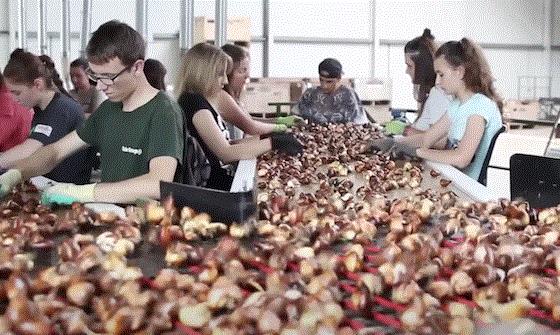
To maximize bulb maturation (which continues after harvest) and to minimize the risk of disease development, growers will be storing their bulbs carefully, monitoring for disease closely and making use of the relatively new “zuur” machines. That’s Dutch for “sour,” indicating the smell of bulbs infected with Fusarium. (An experienced bulb grower like Dick can walk into a storage room and smell the presence of Fusarium). The zuur machines don’t sniff for it, they use X-rays to scan for the disease in bulbs, working much faster and more accurately than humans (but it still isn’t 100% effective).
Ednie is tracking the situation closely and working with their growers to source the most and best bulbs they can, but they expect to be shorted by their growers.
“Our main objective is to make sure the bulbs we’re sending out are good,” he said.
The shortage is concerning, but if your supplier winds up substituting smaller bulbs, don’t despair, Dick says, as bulb size doesn't necessarily indicate the size or quality of the finished plant or flower. As long as the bulb’s core has developed properly, you can produce a good finished crop.
If (and when) you find yourself a bit short on your order, what should you do? Handle the bulbs you do get as carefully as possible, starting with getting them right into the greenhouse and into pots as soon as they arrive. Don’t leave them sitting around for a few days or a week, especially under less-than-optimum conditions.

Bulb production video

In researching this piece, I stumbled across a way-cool video by Noal Farm (3.7 million subscribers!) titled “How 2 Billion Tulip Bulbs Are Produced and Harvested.” I don't know who Noal Farm is (they are NOT a bulb producer), but it’s got some great footage from the bulb fields and processing facilities that will give you a good idea of the process. Check it out! (For full disclosure, this is also where I got that bulb sorting image in the previous item.)
Marvin goes to Alaska
And not for one of his favorite reasons, a wildlife photography workshop. This time, our resident hortistician, Dr. Marvin Miller (technically Ball Seed’s market research manager) was in Alaska to attend one of Certified American Grown’s Field to Vase dinners. I asked Marvin for a brief report on the event:
At the southern tip of Alaska’s Kenai Peninsula, one finds the town of Homer and the nearby Kachemak Bay. In the surrounding area, there are 26 producers of peonies raising the perennial plants for cut flowers. Why peonies in Alaska? Because they typically thrive in the climate and they extend the season, being the latest to bloom in the United States. Alaska-grown peonies allow florists to provide the oft-requested flowers to brides through September and do it with a domestically produced product.
To celebrate this flower and this relatively new industry, the town has just held its fourth annual Homer Peony Festival, which took place through the month of July. Certified American Grown was on hand to celebrate the local peony growers, who are part of the enhanced American cut flower movement, with one of its Field to Vase Dinners. Our hosts were Beth Van Sandt and Kurt Weichhand (below), the husband/wife team who own Scenic Place Peonies. Fifty-six floral professionals and flower enthusiasts from 13 states attended the dinner.
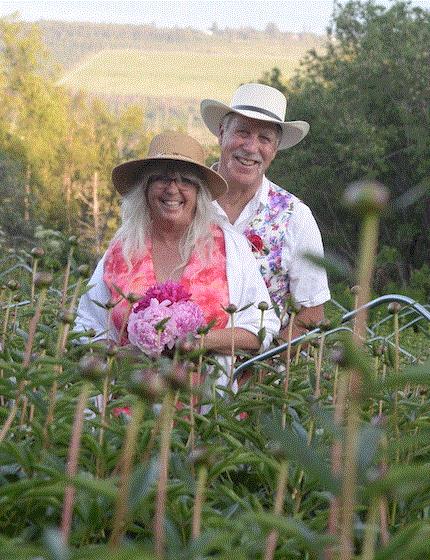
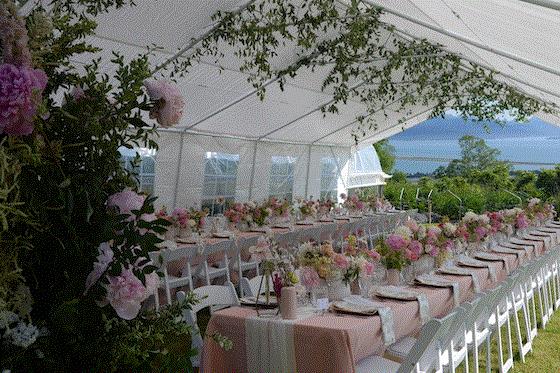
There was just one problem: someone forgot to cue the peonies!
It was an exceptionally late season this year for the growers huddled around Kachemak Bay, and by the time of the dinner July 23, the Van Sandt team had only harvested six peony blooms.
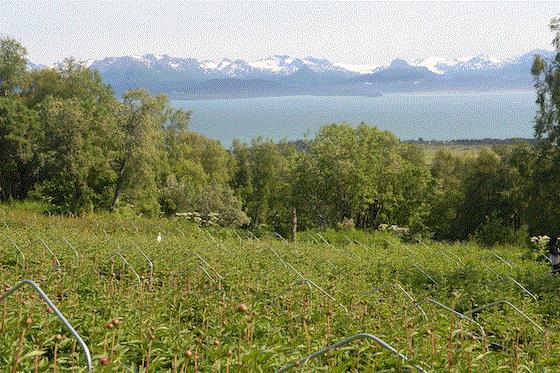 Plenty of peony buds, anyway.
Plenty of peony buds, anyway.
Knowing that the crop was coming in late, Kurt had flown to Fairbanks earlier in the week to retrieve nine cases of peony flowers from a fellow grower, Boreal Peonies in Two Rivers, so that florists Kelly Shore and Jennifer Reed had something with which to work. The season begins earlier in the interior part of the state, but in the Homer area, winds off the glaciers across the Bay, combined with the 1,150 ft. altitude of Scenic Place Peonies, delayed the crop.
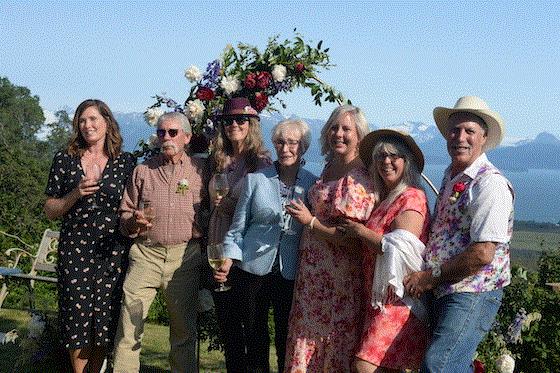 Left to right: Jennifer Reed (a New Jersey florist who helped with the designs), Sean and Gerri Martin from Diamond Ridge Peonies, Rita Jo Shoultz (Alaska Perfect Peony), Kelly Shore (a Maryland florist who led the design team), and Beth Van Sandt and Kurt Weichhand (Scenic Place Peonies).
Left to right: Jennifer Reed (a New Jersey florist who helped with the designs), Sean and Gerri Martin from Diamond Ridge Peonies, Rita Jo Shoultz (Alaska Perfect Peony), Kelly Shore (a Maryland florist who led the design team), and Beth Van Sandt and Kurt Weichhand (Scenic Place Peonies).

Peony Stats (Marvin is a hortistician, after all)
Reportedly, there are over 200 producers of cut peonies in Alaska, but the vast majority are small operations. In the 2019 Census of Horticultural Specialties, there were 463 operations across the United States that reported production of cut peonies and 37 of these were in Alaska.
Yet, if you didn't report at least $10,000 in farm gate value of horticultural crops, you didn't have to complete the Census. This testifies to the nature of the typical Alaskan peony farm. There are many operations with only a small field of peonies, often 1/4 to 1/2 acres in size. And many of the peony operations are run as part-time businesses or they're part of a more diverse agricultural enterprise.
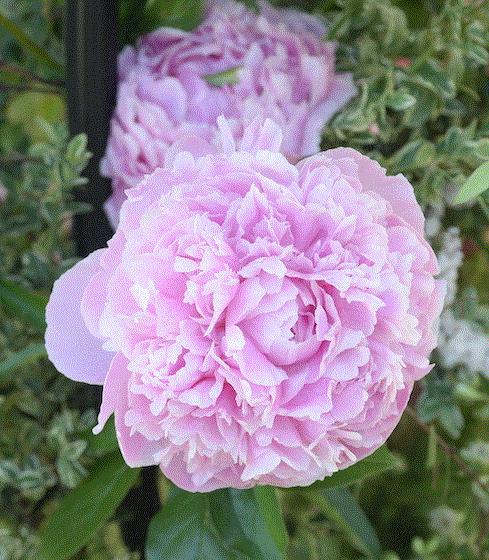
The typical Alaskan peony grower doesn’t talk about the size of their farm or even the acreage of their peony fields; instead, they reference the number of plants they have in production. As an example, what may be the largest peony operation in the state reportedly has about 15,000 plants in production and possibly another 1,200 or so in research plots or variety trials.
For the most part, the Alaska peony industry fills a void in the marketplace, but it's a very important niche. In marketing, we often talk about satisfying the customers’ needs. In the past, we saw domestic peonies in the cut flower market for only about a month or two. Today, thanks to the Alaskan peony industry, we have more than doubled the duration of their market presence and have filled so many more brides’ dreams. And that's quite an accomplishment indeed!

BFG acquires IGC distribution business of Central Garden & Pet
BFG Supply announced August 11 that it had acquired the independent garden center distribution business of Central Garden & Pet (“Central”). The independent garden center distribution portion of Central serves more than 4,000 customers across the United States, selling both Central and third-party-vendor products across the nation. The acquisition “strengthens the leading position of BFG in the independent lawn and garden distribution segment,” said the company in the press release.

If Central’s name rings a faint bell, it’s because that’s the company that bought Maryland-based Bell Nursery back in 2018 from Gary Mangum, Mike McCarthy and their financial partner Lindsay Goldberg.
Headquartered in Burton, Ohio, BFG already distributes a full line of products across many green industry segments, including professional horticulture, lawn & garden, hydroponic, and Controlled Environment Agriculture. This, I presume, will help bulk-up the L&G segment.
Central, for their part, has not released any info about why they sold off this segment, but I’m hoping to learn more. I can only guess that they're retaining non-IGC customers—meaning box and chain stores. Perhaps they want to focus on fewer, larger customers and leave the small guys to a distributor that specializes in them?
If you know, let me know HERE.

Happy 100 to Cottage Gardens!
In the best tradition of the late Willard Scott, here’s wishing happy 100th birthday to Cottage Gardens of Perry, Ohio. The four-generation-old shrub, tree and rose grower celebrated with a big celebration July 19. It’s quite a milestone when you consider that only 3% of businesses make it to the fourth generation.
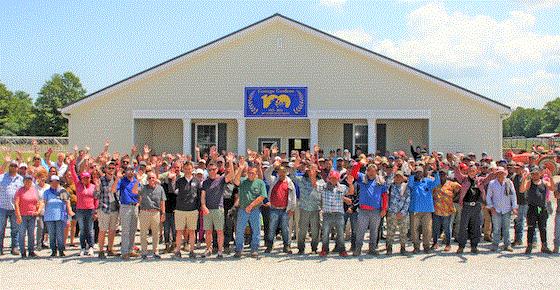
Cottage Gardens was founded by Nick Kriek, who left his sales job with a Holland tulip grower to pursue his dream of running a nursery and landscape business. He started with a small 20-acre farm in Lansing, Michigan. Wilma Hicks, Nick’s daughter, and her husband, Harold Hicks, joined the business in the ’40s, bringing a volume-centered approach, increasing sales through brokering. In 1966, they added their Perry location.
In 1970, Harold and Wilma’s son Bill joined the business. Under Bill’s supervision, Cottage Gardens began growing most of the material it sold. In the ’80s, production shifted from field to container growing, allowing the flexibility to ship year-round. By the 1990s, they broke the 1 million plants per year barrier. In the 2000s, Bill’s sons Nate and Will Hicks, the fourth generation, joined the business. They continue to grow and develop Cottage Gardens, expanding to Stuart, Florida, in 2015, where they grow 34 acres of roses, hydrangeas, buddleia and ornamental grasses; and Smithville, Tennessee, in 2018, where they purchased a 300-acre facility to grow container trees, small fruits, arborvitae and other shrubs. Today, they grow more than 500 varieties on 1,000 acres in four states.
Congrats, and here’s to a few more generations and another 100 years!

P.L. introduces two new LEDs
If you’re in the market for LED lighting for your greenhouse, here are two more options from P.L. Light Systems of Beamsville, Ontario. (Beamsville? How apropos!)
The new lights are in two families: ParFX and TriPlane.
The ParFX Ultra is a high-performance LED top-light that delivers power and precision, they say. It has an ultra-high light output of ≤ 3745 μmol/s and an ideal “bat-wing” light distribution, courtesy of its unique optical lens, which allows for wider row spacing. This lets you achieve your target light levels and achieve consistent crop growth using fewer light fixtures. ParFX is available in high light output (Ultra) or ultra-high output (Ultra Plus) models, depending on the light levels required for the application, and offers multiple standard spectral recipes (including far-red options). Custom spectral recipes can also be accommodated for project level orders.
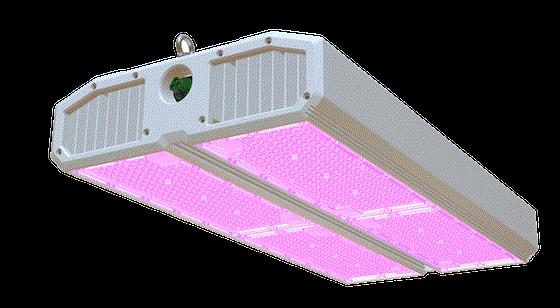 ParFX Ultra
ParFX Ultra
The TriPlane Linear LED is engineered to cast minimal shadowing on the crop canopy while delivering the same performance as the standard TriPlane model. TriPlane Linear offers the ideal combination of form and function in greenhouse applications, they say.
The LED modules of the TriPlane Linear can be mounted back-to-back or spaced further apart, depending on the light level requirements. Driver modules can be mounted vertically or horizontally, either between or above the LED modules.
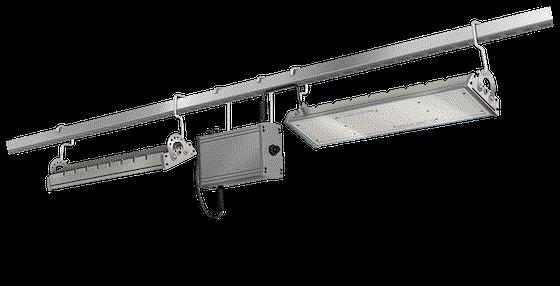 TriPlane Linear
TriPlane Linear
“With the TriPlane Linear, we wanted to retain the growers’ ability to adjust the distribution angle of the LED modules, but offer additional flexibility in terms of mounting configurations to address the challenges faced by greenhouse operators in particular,” explained marketing director Lisa Jansen van Rensburg. “Our design approach at P.L. Light Systems is always purposeful—whether it’s a new luminaire or an update to an existing product.”
The TriPlane Linear is available in the same RWMB and Daylight spectrums as the original standard TriPlane product, as well as a new RWMB_FR spectral recipe. This new recipe is optimized for efficiencies in the red and blue spectrums, with additional far-red content, and is now also available for the standard TriPlane luminaire.
To learn more about the ParFX Ultra, visit pllight.com/products/triplane-linear.
To learn more about the TriPlane Linear luminaire, visit pllight.com/products/parfx-ultra.

Fessler Nursery to distribute leafjoy foliage to the West
Fessler Nursery of Woodburn, Oregon, has partnered with The Plant Company of Stuarts Draft, Virginia, to grow and distribute their leafjoy houseplants in the Western U.S. Fessler will cover Arizona, California, Colorado, Idaho, Montana, New Mexico, Nevada, Oregon, Utah, Washington and Wyoming. leafjoy is the houseplant brand of Proven Winners.
The company officially launched its partnership at the Farwest Show in Portland and will begin delivering plants immediately.
Fessler Nursery, a family-owned grower of indoor plants, said they'll meet the same high quality standards as The Plant Company. They'll be able to provide more economical shipping rates to Western customers than The Plant Company can from its Virginia facility. The 60-year-old nursery has been growing houseplants for about 15 years and is excited to join Proven Winners and the leafjoy brand.
“Being able to partner with a company that has access to the marketing that Proven Winners does adds a lot to our nursery and our growing operation,” said Tanner Fessler, production and sales manager at Fessler. “I think partnering with The Plant Company specifically is amazing since we have the same morals and values and growing philosophies. That’s what makes us a good fit.”

Video tours of the European FlowerTrials
The annual FlowerTrials, held each June over four days in the Netherlands and Germany, is one of the most spectacular flower industry events on the planet. Fifty-plus breeders and plant introducers all exhibiting their glorious wares at the same time … the only thing that would make it better is if the event was in one giant greenhouse instead of dozens spread out over three regions (which makes it almost impossible to see them all … although I’m sure some folks manage).

I attended FlowerTrials last year for the first time and found it quite inspiring! So why don’t I go every year? Because it’s an expensive trip, and anyway, I see most of the varieties in April at the California Spring Trials. And those that I don’t see may not be available to you here in North America and I don’t want to get you excited for something you can’t have.
Anyway, all that is to say that there are now some short VIDEO REPORTS available from the 2023 FlowerTrials, so we can see what we missed! They’ll give you a taste of what FlowerTrials has to offer, in case you’re thinking of checking them out next year (June 11-14, 2024).

Suntory’s newest blue flowers
Do you remember the blue rose Applause and the blue Moon carnation? They were introduced quite a few years back by Suntory, products of a breeding program focused on creating blue flowers in species that have never had blue flowers before.
Now Suntory has a third blue flower, BluOcean Chrysanthemums. Featuring five shades of violet and blue, BlueOcean is the result of a collaboration between Suntory Flowers, Suntory Global Innovation Center, and the National Agriculture and Food Research Organization (NARO) in Japan.
Three of the five introductions: Sapphire, Coral and Purple Sapphire.
Said the announcement about the new flowers, “The collaboration between Suntory group and NARO exemplifies the power of scientific expertise and dedication to pushing the boundaries of what is possible in plant breeding. Combining Suntory’s and NARO’s expertise in genetic modification to modify flower color and deep understanding of chrysanthemums research, the teams worked tirelessly to develop a chrysanthemum with an enchanting blue hue, previously unseen in nature.”
These are cut mums that are ideal for professional florists who are “seeking to elevate their floral arrangements with an elegant touch of blue.” Production has been licensed to growers in South America. Finished cuts should be available to the floral trade in September.
Why BluOcean? To represent Suntory’s high priority on the sustainability of water, an important raw ingredient for their beverage businesses, they say.

Finally …
We editors enjoy sharing the various “colors of the year” with you because we figure 1) paint is a cheap way for you retailers to freshen up parts of your garden centers; 2) you growers can match pots and flowers to it; and 3) you breeders love to find varieties that match the trendy color.
That brings us to Behr’s 2024 Color of the Year: Cracked Pepper.
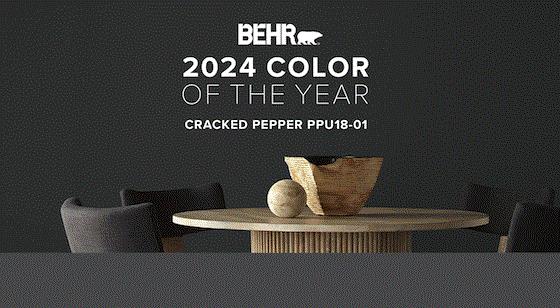
Jen Polanz pointed this one out to us fellow editors (she called it "dark"). I quickly weighed in that I have personal experience with “soft black,” having painted the legs and apron of my natural-wood dining table a similar shade. It’s super chic—just ask famous HGTV design personality Allison Victoria, who's constantly sourcing random antiques and painting them soft black, or built-ins or kitchen cabinets. Her style is “Modern French Luxe” (or so THIS website says) and you can see the color repeated throughout.
Tell me houseplants wouldn’t pop if displayed on this unit:

And nothing beats a dark gray/black pot for making green foliage look fantastic. The Europeans already know this:
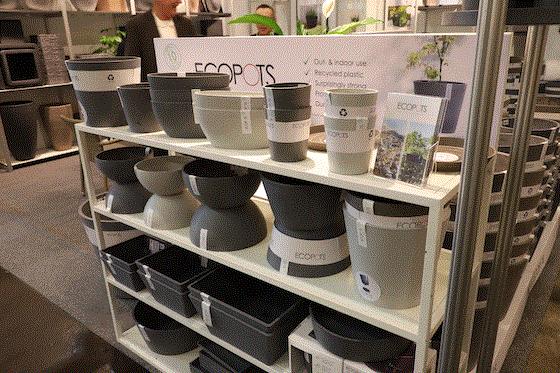
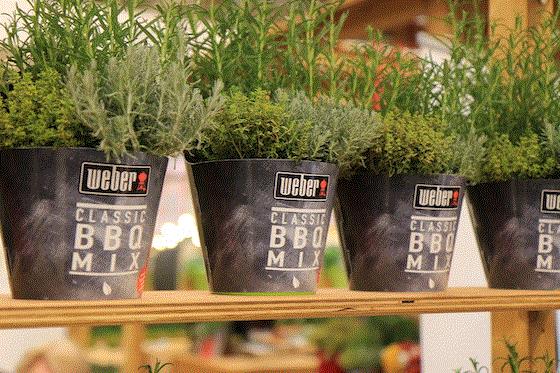
In looking at these photos, I recall that my very first floral industry job was for a florist/houseplant shop in Florida called Tropical Treehouse, the interior of which was all black—walls, shelves, I think even the ceiling. I noted then the striking contrast it gave the flowers and plants.
Give some soft black/Cracked Pepper a try and let me know how it works for you!



Feel free to email me at beytes@growertalks.com if you have ideas, comments or questions.
See you next time,

Chris Beytes
Editor
GrowerTalks and Green Profit
This e-mail received by 26,439 loyal readers!
Thanks to my loyal sponsors, who help me reach the 26,439 readers of Acres Online in more than 60 countries. Want to be one of them (a sponsor, that is)? Give Kim Brown a shout and she will tell you about our many advertising opportunities.